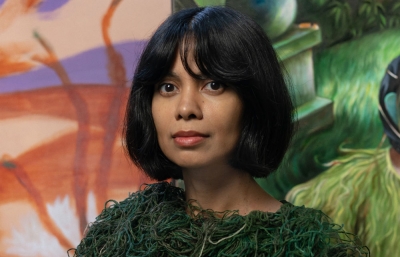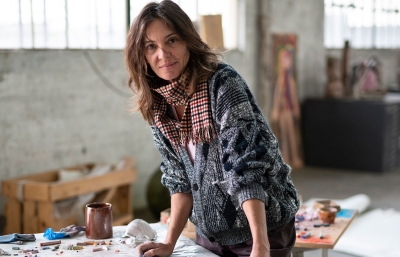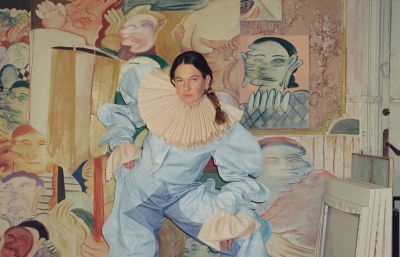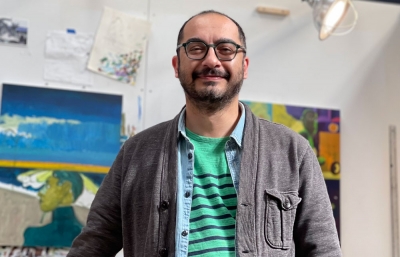Katherine Bernhardt
Everlasting Butter
Interview by Kristin Farr // Portrait by Wil Driscoll
Refreshment is rare at an art fair, until you round a corner and meet an instantly recognizable Pink Panther in the shower, an oozy E.T., or a colorfield of Crocs. Like running into your coolest friend amidst a crowd of squares, Katherine Bernhardt paintings punctuate art scenes with fresh air. Incomparably effervescent, Bernhardt’s aesthetic reflects in her style and surroundings, including the famous pink house in St. Louis. Her frame of reference is worldwide, and she paints like butter, which is also her most recent subject.
Kristin Farr: What’s your “in and out” list for 2024?
Katherine Bernhardt: I’ve always followed what’s been in or not. Right now, I’m listening to the Nigerian singers Burna Boy and Asake, and the British rapper Central Cee. I like the mixture of how they sing, with lyrics from different languages mixed together at the same time. For me, they’re in. I also love watching Kanye West and his wife walk around with a pillow as an outfit.

Any other current pop culture inspirations?
I’m into timeless things that don’t go out of style. Things that never go out of fashion for me include the immensity of cultures found in places like Mexico City or Ancient Rome.
These days, I’m also interested in butter and the image of butter, and that’s been around for a while, too. I looked up the origins of butter and found that it dates back to Neolithic-era Africa from 8000 BCE, so butter’s been around longer than lots of things on our planet.
Let’s talk about how Dutch wax prints inspired you.
I am very interested in textiles in general. I love the heavily-embroidered huipils from Guatemala and Moroccan hand-woven rugs. I also love Dutch wax prints for two reasons: they’re made of funny patterned combinations of miscellaneous things, and because they’re so colorful. They can be a mixture of random stuff such as bananas, an ironing board, the face of Barack Obama, birds, high-heeled shoes, flying saucers, sticks of dynamite, tropical flowers, or whatever. They can be based on anything that pops into the mind of the textile designer. I love textiles and patterns, so these prints have always caught my eye. It’s very fun to wear patterns, and I love patterns in art, design, fashion, and furniture.
Have you made any custom Crocs Jibbitz?
No, not yet. But I want to design a Croc or a set of Crocs.

What’s the balance of intentional versus spontaneous in your practice?
My work is a mixture of both. Intentional work would be when I use a spray paint can to make a drawing of something on a canvas. Then, putting it on the floor and using lots of water in colors creates something on its own, which is spontaneous.
Is water a collaborator?
Water is everywhere in my work, on all levels. I love being in a pool, and that’s where I think about things. I like to float in water. I love swimming outside in Puerto Rico and Greece. I love water in my paintings. I’m also an Aquarius—the water bearer. I like to put water in between lines of spray paint. Water works on my paintings for me, and it changes them.
What are the top five elements in your painting vocabulary?
The top five words I would use to describe my paintings are: short, fast, athletic, beautiful, and vivacious.
In art, the word grotesque can actually refer to something the artist finds beautiful. Do you think about that juxtaposition?
Sometimes I try to make colors that would clash, be hideous together, or appear very obnoxious, but then they might end up turning out well next to each other. Sometimes they are opposite shades of color. Extra amounts of water help mix them, which helps them get along and look good together. I like to see monsters in paintings. I enjoy seeing them eating things and stuffing things into their mouths, like Cookie Monster; there’s an element of the grotesque in monsters that I find exhilarating and beautiful. Intricately painted monsters are often seen in medieval paintings eating things, as well as people in Hell—and that’s definitely grotesque.
What makes a painting bad, in your mind?
When there is no energy in it, that’s bad. Also, if it’s unfinished or made of bad or boring colors.

Since the NYT video about your Lindell house in St. Louis last summer, have there been any new acquisitions or notable visitors?
I recently found two mint condition Robert Venturi chairs—those are the flattened plywood postmodern chairs with the fun Grandmother pattern floral coverings on them that were based on an elegant prototype of an eighteenth-century Queen Anne chair. I’m also always on the lookout for interesting art for sale, and I buy a lot of stuff at auction.
As far as visitors, recently I’ve had over the designer Jeremy Scott and some soccer players: John Bell, Aziel Jackson, and Niko Gioacchini. Herb Smith, who had the Lindell house built by Gary Glenn, just came over to talk about it. And the NY-based artist Derrick Adams stopped over recently, as did the Brazilian artist Zeh Palito.
Had you always noticed the house before you bought it? And tell us about how you turned it into a museum-level masterpiece.
In 1986, it was built by Gary Glenn, who had studied at the famous School of Architecture down the street at Washington University. He loved the style of Le Corbusier, and during WWII, he worked as a mapmaker, which was somewhat related to his work as a draftsman and architect. After the war, he built two modernistic houses in St. Louis and also remodeled other ones across Missouri.
And yes, since I was little, I had always noticed this house on Lindell! The house is a total inspiration and my muse. And thanks for calling it a masterpiece! I have tried to make it into something interesting. At the Missouri History Museum, located across the street from the house, they had images of what it used to look like, so it was renovated based on that.
I then added new colorful elements, like the terrazzo floors downstairs, different carpet colors upstairs, and colorful tiles around the pool, and I’ve placed a lot of colorful art everywhere—stuff that I’ve collected over the years.
What do you love about showers and bathroom tile?
Since I love water, I love bathrooms in general. I love being in the jacuzzi. I based the shower designs off an Italian Superstudio design from the 1970s. I created my own Superstudio and then added different colored tiles matched with different colored grouts to personalize each bathroom. I love the minimalistic aesthetic of bathrooms with monochromatic tile schemes from the ’70s and ’80s.

Remember, in the ’80s, when kids wore multiple Swatches and jelly bracelets? Why do you think the aesthetic of the ’80s is so unforgettable?
Yes, I remember all that. And I did all that, and so did my friends. I especially loved the Swatch watches. Back in the ’80s, one of my favorite pastimes was going to Dillard’s, a nearby department store, to look at the Swatch watches for sale. Swatches came out in 1983, and I remember being there when they were first displayed behind glass like jewels. It was so exciting to see them all laid out there and to think about all of their designs and colors and what they represented from the rest of the world. It was a phenomenon on planet Earth. And ’80s style infiltrated everything: design, fashion, music, hair, the supermodels, Memphis design, Boy George, Duran Duran, and all that design influenced me to my core in my formative years.
Even though I didn’t know the context or much about where it came from at the time, I loved the Ettore Sottsass designs at our local Esprit store. Beyond the Swatches, Dillard’s also had a section of Esprit, so I spent a lot of time there looking and thinking. I was also really into the music: Depeche Mode, Cindy Lauper, the Cure, Madonna... I also remember collecting and closely examining the famous ’80s Benetton catalog.
The ’80s designs were radical, like the radical Italian design, and they were unforgettable because they had bold color schemes.
What are some other muses?
Right now, I’m inspired by the St. Louis City soccer team. The players are great, and I also love the new stadium design. The nighttime lighting is a pinkish red; the amazing adjacent parking lot with a high-tech outdoor staircase recalls the one at the Centre Pompidou, and the games bring so much inspiration and energy to St. Louis. It’s near midtown St. Louis, known as the Design District, where my studio is located, and it’s part of what has become a cool area in the city.
Have your paintings changed since moving back to St. Louis from New York?
Everything is always changing. I have a bigger studio here, so I can make bigger stuff and more stuff. But my ideas are always in my brain, so it doesn’t matter where I’m located, I’m going to be interested in the same things wherever I am painting. I’m able to look at the same stuff that everyone else is looking at. I’ve been making a new series of paintings that are soft and pastel.
Tell me about your most memorable art trades.
My trades have been great. I feel very lucky about them. I recently traded one of my Pink Panther paintings to Leo Koenig for five of his pieces of rare, unproduced vintage Memphis furniture, including the elegant Del Diavolo mirror and a sleek and curvy marble console.
I also love my Raphael Ferrer and my Chris Martin glitter painting—both acquired through trades. A lot of my collection is due to trading, including the work in my house by Eddy Martinez, Zeh Palito, Marcus Jamal, Joanne Greenberg, Jose Luis Vargas, Kiván Quiñones Beltrán, Jerry Wilkerson and others.

What’s happening at your gallery space, Dragon, Crab, and Turtle?
Right now, it’s a showroom of my art. I might also use the space to collect some cool furniture by Memphis Milano, Gufram, Gaetano Pesce, and other things I find in St. Louis at CENTRO and at Link Auction Gallery. Next fall, Dragon, Crab and Turtle is planning a show based on the work of the artist Adam Lavigne, who used to work as my studio assistant.
Is it true you’re building a place in Puerto Rico?
Yes, a tropical brutalism style house in Old San Juan. My architects are José Toro and Sotirios Kotoulas, who are collaborating on it and who have both taught at the University of Puerto Rico. The structure will be made of poured concrete, and it will include skylights, a swimming pool on the roof, plants growing out of the roof that will “fall” and cover the house, and the inside will be all about concrete, mirrors, and plants. It will represent minimalism and brutalism, yet, from the street-level outside, it will all be set behind the surviving old walls of an historic colonial structure, and will look old and remain an early modern structure like all of the others built several hundred years ago in Old San Juan.
What are your favorite types of rocks, and why?
My favorite rocks on Earth are the rocks behind Casa Cubuy in Puerto Rico. They are giant boulders that have fallen down a hillside, forming a riverbed, where they create an amazing waterfall and various swimming pools as the gigantic rocks descend the valley. It looks like Heaven on Earth and is out of this world.
It is also refreshing to go swimming at Charcoal El Hippie and in other huge rock gorges around the island. I also like the exhibit of rocks at the Natural History Museum in NYC. I like Michael Heizer’s Levitated Mass rock suspended between the outdoor walkway at the LACMA. I like the rock houses in Cappadocia. I like the Trulli and Sassi homes in southern Italy. I like terrazzo floors that are made of cut-up rocks. I like Elephant Rock Park near St. Louis. And I love the huge rock slab house that I’ve seen in photos, but I don’t know where it is.
Tell me about a place you’ve traveled that most influenced your taste?
When I was fifteen, I was an exchange student for a summer in Portugal, and we took a trip to Morocco. That was a total eye opener and a shock to my system. Going to Tetouan and seeing all of the people wearing their colorful caftans and staying in the riads, looking at the intricate tile work and all of the different colors and designs of everything, seeing all of that amazing stuff sold in the souks, and absolutely everything there looked and felt amazing. It led me to read books by Paul Bowles too. I never got over it. Then, much more recently, a trip to Brazil got me interested in tropical architecture and the environment.
What’s the most inspiring store you’ve ever been to?
That would be the souks in Morocco, like Jemaa el-Fnaa in Marrakech. The spice markets, the rug markets like Palais Filali, the clothing, and all of the other fascinating stores nearby are awesome. They’ve been around that square for over 1,000 years.
Please list everything you love that is pink.
Gaetano Pesce’s pink polyurethane Pescetrullo house in Puglia, Luis Barrágon’s huge pink walls in Mexico at the Cuadra San Cristóbal or at the Casa Estudio Luis Barrágon, my pink house—the Lindell house is painted in a couple of shades of pink on the back side, the David Hockney house in the Hollywood Hills, Julian Scnhabel’s Palazzo Chupi in the West Village, pink sunrises and sunsets, pink flamingos, Matisse’s pink room paintings, the Pink Panther, Philip Guston’s paintings, the Royal Hawaiian hotel, pink lipstick, Zeh Palito’s pink paintings and murals. It’s funny because I hate red, but pink is made from red, so I guess I have to respect red!
Let’s imagine Planet Katherine Bernhardt, where you design absolutely everything.
I never thought of that. A planet filled with some stuff I love could look a lot like Brasilia—the awesome modernist mid-century capital of Brazil designed by Oscar Neimeyer. The planet could be dotted with tons of that kind of large-scale concrete architecture, and the buildings could be monumental and extreme. Their grandiosity, brutalism, and neutral color schemes would go well with natural landscapes and nature across the planet. That would be an interesting setting. The ideal planet would also be a world where amazing, gigantic native wild flowers would grow everywhere. There would be fresh air and good design everywhere.

What is something important to you that seems unimportant to most other people?
Every single thing my son says and does.
Has he influenced your paintings?
Khalifa’s an important inspiration and influence on my work and in life. He’s funny, humorous and always making jokes. He likes to cause a ruckus and create scenes, and he’s also a creative chef. He’s inspiring in many ways. He’s also half Moroccan, so Morocco and its culture have inspired a lot of my work for years. His interest in Pokémon led me to a series and some shows about those Pocket Monsters. Khalifa also loves his sneaker collection, and I paint those, too. We have similar interests.
Let’s ask him a few questions. Hi, Khalifa. Which of your Mom’s paintings are your favorites, and what was your favorite exhibit of hers?
Khalifa Jdia-Bernhardt: I love her Chanel paintings the most, maybe because right now I’m going through a phase related to fragrances and smelling good. And my favorite exhibit of hers was in 2022 in London, Why is a Mushroom Growing in My Shower? I really like Crocs, and it’s the only show I can think of right now.

How does traveling inspire you and your mom?
Traveling inspires me for lots of reasons, but mostly for culinary reasons, seeing different cultures, and learning about how soccer unites the world. It’s incredible to experience the food of different countries. Vietnamese and Japanese foods are my favorites.
What kind of art have you been making recently?
I play soccer, so for an art project at school, I created a sculpture of a soccer field made out of cardboard that I painted. I also made a cardboard jersey based on Richarlison’s Brazilian one on the day that he made an incredible bicycle kick.
What do you like about living in the Lindell house?
I like cooking, so I like the spacious kitchen. Swimming and using the jacuzzi in winter is so fun, and I also have a soccer field in the backyard. The location is great too: It faces Forest Park and all of its trees, and the Art Museum is on the horizon.
What’s your Mom like when she’s painting in the studio?
She’s locked in.
Bernhardt will open a two-person show with designer Jeremy Scott at Nerman Museum of Contemporary Art in February, 2025. Follow Katherine and Khalifa’s travels @kbernhardt2014 // This interview was originally published in our SUMMER 2024 Quarterly






